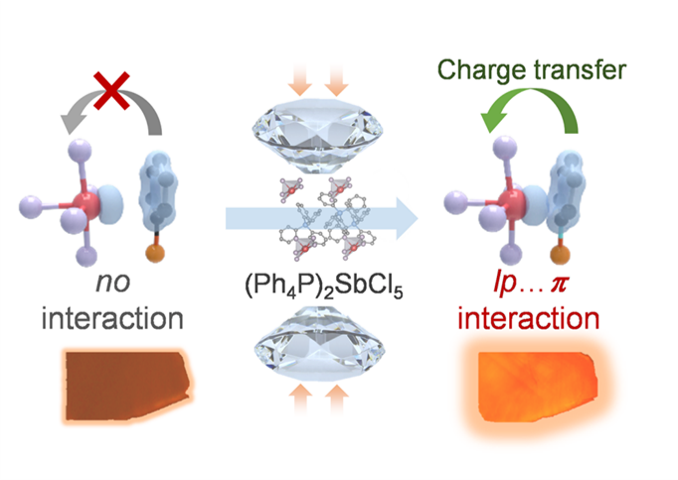
Organic-inorganic hybrid materials provide integrated platforms for modern technologies. Low-dimensional (low-D) organic metal halide hybrids (OMHHs) have emerged as promising materials for new-generation optoelectronic devices due to their integrated properties from organic and inorganic components. However, for most low-D OMHHs developed to date, especially the zero-D (0D) compounds, the inferior electronic coupling between organic ligands and inorganic metal halides prevents charge transfer at the hybrid interfaces and limits the tunability of their optical and electronic properties. A new study led by Dr. Xujiie Lü and a team of scientists from HPSTAR, reveals the underlying mechanisms at play and proposes techniques to overcome these challenges. Anomalous Charge Transfer from Organic Ligands to Metal Halides in Zero-Dimensional [(C6H5)4P]2SbCl5 Enabled by Pressure-Induced Lone Pair-π Interaction is published in Angewandte Chemie International Edition.
Using pressure engineering, Dr. Lü et al. report spontaneously efficient charge transfer from organic ligands to metal halides in 0D OMHHs (Ph4P)2SbCl5 leading to high emission with a 100% PLQY from self-trapped excitons. Combined in situ experimental diagnostics and theoretical simulations elucidate the underlying mechanisms. The pressure-induced strong coupling between the lone-pair electrons of Sb3+ and the π electrons of the benzene ring (lp-π interaction) serves as an unexpected “bridge” for the interfacial charge transfer. Such an lp-π interaction has never been reported in organic-inorganic metal halide materials. Furthermore, the pressure-induced transition of energy-level alignment from type-II to quasi-type-I provides the driving force for the charge transfer from ligands to metal halides, together resulting in the high emission with a 99% PLQY at the metal halides.

Caption: Pressure induced lone pair-π interaction and realize charge transfer from ligands to metal halides.
By manipulating the lp-π interactions in organic-inorganic hybrid systems, this work realizes an anomalously efficient charge transfer at the hybrid interface of 0D OMHHs, introducing a versatile strategy for the design and optimization of functional materials.